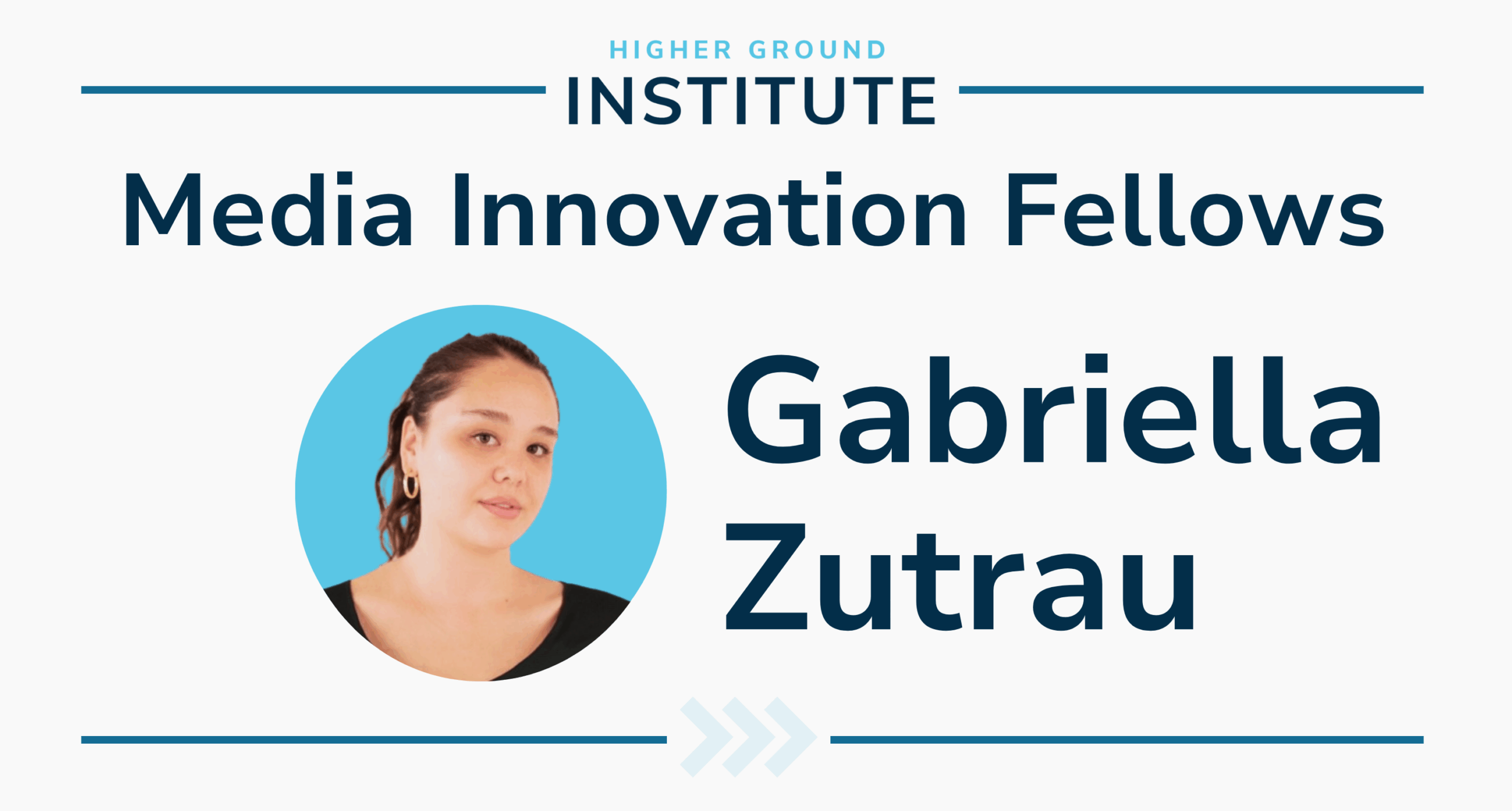Over the summer, Higher Ground Institute has been supporting our incredible 2025 HGI Media Innovation Fellows in kickstarting their visions for the progressive media space. Over the next few weeks, we will be featuring each of our six fellows who are focused on projects at the intersection of political engagement and digital media. This is the first in that series.
Today we’re excited to introduce our newest Media Innovation Fellow, Gabriella Zutrau: a digital strategist whose passion for turning online engagement into tangible, real-world impact has made her a sought-after consultant in progressive politics and nonprofit communications. Through her innovative work with tools like Manychat (an Instagram-based chatbot system) for the Zohran Mamdani campaign, Gabbi has pioneered methods to capture and convert digital enthusiasm into offline actions such as votes, volunteer sign-ups, and campaign support.
Her project for the Higher Ground Institute Media Innovation Fellowship, “Prepare to Go Viral: Turning Internet Enthusiasm Into Offline Impact” seeks to address a critical challenge: equipping campaigns and organizations to capitalize effectively on moments of heightened digital attention. Gabbi aims to create scalable resources grounded in practical advice that help progressive digital teams anticipate and harness viral opportunities, overcoming budgetary, behavioral, and psychological barriers that often hinder the adoption of new digital organizing tactics.
We asked Gabriella to share more about her unique background, approach to organizing, and vision for the future of campaigning:

HGI: How did your personal background and professional experiences plant the seed for this project?
Gabriella: When I first got involved in politics, I was a student organizer then eventually a community organizer. But beginning in 2016, it became clear to me that my physical disability was going to prevent me from consistently being able to make it out to the streets for protests or to in-person organizing events. That’s when I started gravitating more towards digital organizing and communications, so that I could continue using my organizing skillset in a way that was remote and less physically demanding. For about a decade, I have been helping progressive and socialist campaigns and organizations build communities online and translate that engagement into IRL actions and results.
In a very different lane, I have also used my expertise in organic social media strategy that I developed in the politics and nonprofit worlds, to become a content creator in the pet niche. My dog Edna the Runt has hundreds of thousands of followers across platforms, and I use her pages as a lab where I experiment with new digital tools and tactics. I gain a lot of inspiration for my work in political digital through my work on her pages, and through the creator-side exposure it has given me to the creator economy.
I first encountered social media chatbots like Manychat through fellow creators who began using it a couple of years ago. I instantly knew that Manychat could be leveraged as a powerful tool in politics and advocacy, and I began using it with my clients to boost their mid-funnel digital organizing operations. After a year and a half of experimentation, I most recently used Manychat on Zohran Mamdani’s mayoral campaign, generating over 21,000 clicks from DMs and turning over 10,000 Instagram users into contacts on their owned lists in just two months.
Now I’m creating resources to share what I’ve learned working with this technology. I aim to scale up my ability to help campaigns, organizations, and politically aligned creators make the most of the tools available to them in order to turn Internet enthusiasm into offline volunteers, votes, and victories.

HGI: What problem or opportunity are you aiming to address as a Media Innovation Fellow?
Gabriella: All of my clients eventually ask the same question: how do we turn Internet enthusiasm into offline action? My hope is to help organizations and campaigns capture and convert social media audiences at the source, in order to organize those new contacts up their ladder of engagement. By preparing for key moments, we can take full advantage of virality with appropriate digital infrastructure and best practices, and ensure that our biggest fans stay engaged beyond social media. Our contact with our most enthusiastic supporters shouldn’t end when they close Instagram.
HGI: In what ways is your approach leveraging innovation or emerging technologies differently than current tools or strategies?
Gabriella: The playbook for using Manychat for advocacy or electoral campaigning doesn’t exist yet, and most digital practitioners aren’t super familiar with it as a tool. Political creators are a key exception here though; many of them have been using Manychat for a while.
I’ll be sharing my learnings from over a year and a half of pioneering the use of Manychat as a digital organizing tool, and shedding light on why, when, and how to most effectively adopt it and other related digital infrastructure and best practices. I aim to help campaigns and organizations make the most of their content strategy and breakout social moments—and to plan for them before they happen—so no one is left wondering how to turn a large Instagram following into an active base off of social media.
HGI: What’s one popular assumption or myth that you’re excited to challenge or disrupt?
Gabriella: That automations and chatbots should be avoided because they will always feel spammy and annoy people. We should not be trying to trick people into thinking that they’re talking to a real person, which will always feel spammy. The point is to meet your most excited supporters where they’re at and where they’d otherwise be encountering silence, and to use automation to do that at scale. Tagging systems and conditional commands within chatbot flows can prevent automations from feeling super spammy to users, while providing important resources and opportunities to engage.
It’s very clear that people want to be engaged in the political process, and they want to get organized and understand where they can plug in, and giving them these resources at scale is actually a valuable, trust-building service that we can provide to them. And, of course, I’d be remiss if I didn’t mention that this process only remains an organizing tool and a trust builder if people are then given tangible next steps to engage and continue to get value out of being on your list. It will likely do the opposite if their email is just captured to send them periodic fundraising texts.

HGI: If a local, first-time candidate came to you with a small budget, what is the most important piece of advice you would give them about using social media to build a movement?
You’ve heard it before, and you’ll hear it again: consistency is key!
- Posting consistently will build you an audience. Your enemy is not the algorithm; your enemy is burnout. Post as much quality content as you realistically can, at a consistent cadence, without burning out. Whatever you do, do not try to post every day and then burn out and pause posting altogether. Your cadence should be relatively consistent to remain algorithmically relevant to your audience and continue to be served up in people’s feeds. Sometimes that means hiring people to make content for you. But if all you can manage is four pieces of content per month, it is much better to post one piece per week for four weeks than to post every day for four days and not again for the next three and a half weeks. Stay in people’s feeds by consistently posting.
- How? You can quickly create a large volume of quality content by repurposing longer-form writing into shorter sound bites, tweets, and video scripts. Take an op-ed, or your platform from your website, or a speech, and cut up, reorganize, and recycle that content into small digestible social-friendly pieces in as many ways as you can.
- Buy yourself time and relevance by engaging people on your Instagram, Facebook, or TikTok stories. Even if you don’t have time to create a high-production video or a direct-to-camera clip, giving people interactive elements to engage with on your stories (polls, question boxes, emoji sliders, etc.) builds algorithmic relevance with your warmest audience, increasing the likelihood that they’ll be served your future posts.
You can learn more about the Higher Ground Institute Media Innovation Fellowship program and the other Fellows here.



